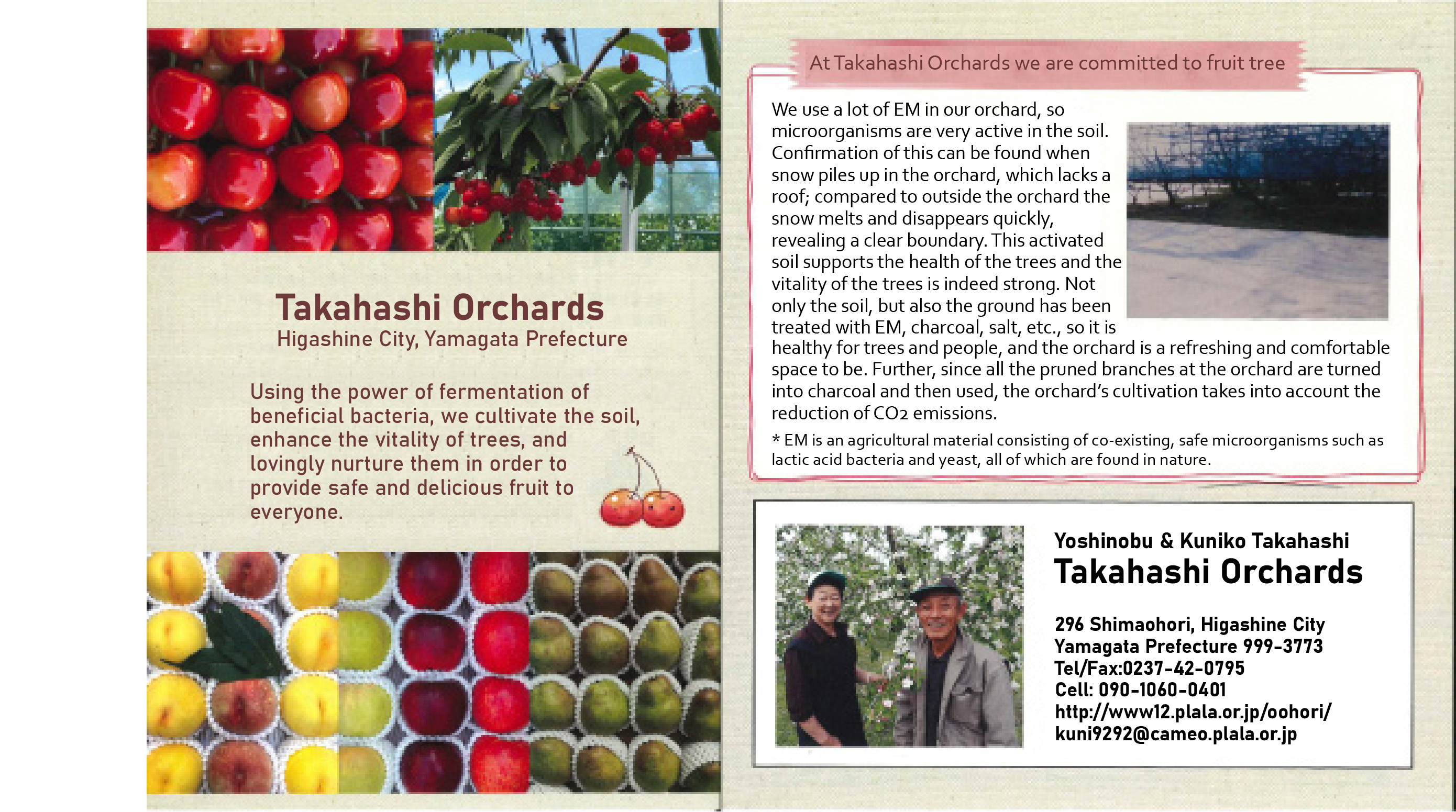Dr.Teruo Higa’s
Living A Dream
- 2025
- Sep:#209 The Widespread Use of EM in Ecuador
- Sep:#208 The Widespread Use of EM in Chile
- Jul:#207 Peru, where EM has taken root throughout the country
- May:#206 EM Application Technology in Paraguay Begins to Evolve into Advanced Circular Agriculture
- May:#205 Practical Application of Soil Disinfectant-Free Cultivation Using EM Technology
- Apr:#204 How EM Use Has Spread Throughout the Philippines
- Mar:#203 How to Use EM to Fundamentally Solve the Problem of Agricultural Residue Burning
- Feb:#202 The Spread of EM technology in Germany
- Jan:#201 The 2nd Ichiro Masaki Memorial Universal Village EM International Conference
- Jan:#200 Cleanup of the Ala Wai Canal in Hawaii, where social bonds are strengthened using EM
- 2024
- Nov:#199 EM trials in India with bananas, tomatoes, and pomegranates
- Oct:#198 The Steadily Evolving EM Nature Farming Method at the Blue Sky Palace - Part 8
- Sep:#197 The Steadily Evolving EM Nature Farming Method at the Blue Sky Palace - Part 7
- Aug:#196 The Steadily Evolving EM Nature Farming Method at the Blue Sky Palace - Part 6
- Jul:#195 The Steadily Evolving EM Nature Farming Method at the Blue Sky Palace - Part 5
- Jun:#194 Steadily Evolving EM Nature Farming Method at the Blue Sky Palace - Part 4
- May:#193 Steadily Evolving EM Nature Farming Method at the Blue Sky Palace - Part 3
- May:#192 Steadily Evolving EM Nature Farming Method at the Blue Sky Palace - Part 2
- Apr:#191 Steadily Evolving EM Nature Farming Method at the Blue Sky Palace
- Mar:#190 Quantum Mechanical Effects of EM Gravitron Charcoal
- Mar:#189 The barrier space in Okinawa (Ryukyu Islands) has risen to another dimension
- Jan:#188 Sixty Days after Typhoon No.6
- 2023
- Oct:#187 Supermassive Typhoon No.6 and Subsequent Typhoon No. 11
- Sep:#186 Massive Typhoon No.6 that swallowed the Ryukyu Islands Graviton barrier
- Sep:#185 August 8th is World “EM Mudball Day”
- Aug:#184 A disease-free life depends on the health of the intestinal microbiome.
- Jul:#183 Trial and Error at the Blue-Sky Palace, Part 3
- Jun:#182 Trial and Error at the Blue-Sky Palace, Part 2
- Apr:#181 Trial and Error at the Blue-Sky Palace
- Mar:#180 Ala Wai Canal Cleanup Project in Waikiki, Hawaii
- Feb:#179 High-Yield, High-Quality Rice Production Using EM
- Feb:#178 The Progress the "Soil Preparation Workshop" of the Oishi 3-chan Club (Part 2)
- Jan:#177 Organic Farming Instructional Manual Using EM
- 2022
- Nov:#176 The Typhoon Situation in Okinawa in 2022
- Sep:#175 Third-Party Verification of the Graviton barrier in Okinawa Part-2
- Sep:#174 Third-Party Verification of the Graviton barrier in Okinawa
- Aug:#173 Ecosystem Changes Observed in Okinawa in 2021 Part-5
- Jun:#172 Ecosystem Changes Observed in Okinawa in 2021 Part-4
- May:#171 Ecosystem Changes Observed in Okinawa in 2021 Part-3
- Apr:#170 Ecosystem Changes Observed in Okinawa in 2021 Part-2
- Mar:#169 Koizumi Farm in Kamakura Continues to Evolve
- Feb:#168 Ecosystem Changes Observed in Okinawa in 2021 Part-1
- 2021
- Dec:#167 Enjoying EM Technology While Enriching the Local Ecosystem
- Nov:#166 A Case Study of the Use of EM in a Next Generation Free School in Tune with the Cycles of Nature
- Oct:#165 Typhoon conditions and flowers in Okinawa from August to October
- Sep:#164 Re-learning the origins of river purification using EM Cleaning up the Dairyuji River in Senami (Murakami City, Niigata Prefecture)
- Aug:#163 Measures Against Natural Disasters and Re-learning the Starting Point of EM
- Jul:#162 Summary of FFC (Foods for Children) Okinawa Forum 2021
- Jun:#161 Restoring the Vigor of an Old Tree and Purifying the Environment with EM Technology That Even an Amateur Can Do
- May:#160 The Public is Beginning to Recognize the Use of EM Smokeless Carbonizers
- Apr:#159 EM Hado (EM Graviton) that exerts quantum superposition effect over time
- Mar:#158 Virus-free Okinawan Plants Through Use of an EM Graviton Barrier
- Jan:#157 Enjoyable Farming for Self-Sufficiency that Even Amateurs Can Do
- 2020
- Dec:#156 EM quantum energy effect occurring in Okinawa
- Nov:#155 Implementing EM graviton farming as a flood countermeasure for apple orchards
- Oct:#154 The Latest Book on the Practical Uses of EM "You Are the One Who Draws Out the Power of Microorganisms," by Chizuko Nomoto
- Sep:#153 Application of EM technology to long periods of rain, lack of sunshine, storms, heavy rains, etc.
- Aug:#152 EM application in Kitanakagusuku village plant waste recycling yard
- Jul:#151 Natural Disaster Countermeasures Using EM Technology: Part 2
- Jul:#150 Natural Disaster Countermeasures Using EM Technology
- May:#149 How to make your home and workplace an energy spot by living a complete EM lifestyle: creating the ultimate source of health and environmental purification
- Apr:#148 EM, Viruses and the Pandemic
- Apr:#147 New agriculture applying quantum mechanics Part 2
- Apr:#146 New agriculture applying quantum mechanics
- Apr:#145 Wonderful EM Miracle
- 2019
- Nov:#144 The movie “Revival II” and the reality of Fukushima
- Oct:#143 Boundary dome and foliar spraying of EM・X GOLD and EM 3
- Oct:#142 Kirakira (Sparkling) Summer Vegetable Festa in 2019
- Aug:#141 Excessive salt inevitably causes salt damage
- Jul:#140 Diverse applications of charcoal Part 3
- Jun:#139 Diverse applications of charcoal Part 2
- Jun:#138 Diverse applications of charcoal
- Jun:#137 Purification power of salt
- May:#136 The degree of soil contamination is a reflection of the microflora
- May:#135 Definitive use of EM barriers to deal with typhoons
- May:#134 Implementing authentic Nature Farming
- May:#133 How to enhance healthy Hado (wave energy) by EM
- May:#132 Eating Dirt (Soil)
- May:#131 Hado (Wave energy) involved in health
- May:#130 Reaffirming EM technology to realize the essence of agriculture
- May:#129 The 2nd EM Producer Networking Meeting
- Apr:#128 Understanding the application of seawater and salt in crop cultivation
- Apr:#127 Prevention of Disasters by EM Technology
- Mar:#126 Quantum overlay effective utilization of EM
- Jan:#125 EM Disaster Recovery Support Projects in 2017
- 2018
- 2017
- Aug:#121 Escape from conventional agricultural traps
- Jul:#120 Limitation and important caveats regarding utilization of salt
- Jun:#119 EM Technology to Break Through the Limits of Pesticide-Free Strawberries
- May:#118 Application of barriers using EM rectification force
- Apr:#117 The 1st EM Produce Growers' Networking Conference
- Mar:#116 Sumizo kun: The Ultimate Versatile Carbonization Equipment
- Feb:#115 How to make and use simple carbonized and rectified ash
- Jan:#114 Achievements of 2016
- 2016
- Dec:#113 Definitive Measures Against Typhoons
- Nov:#112 International Conference on Universal Village
- Oct:#111 90% of Your Body is Microbes
- Sep:#110 Disaster Countermeasures Using EM
- Aug:#109: Changes in the Natural Environment by EM Barrier Domes in Okinawa
- Jul:#108: Multi-purpose Utilization of Activated EM with Seawater and Salt
- Jun:#107: Marine Day, when EM Mudballs and Activated EM are Applied Throughout Japan
- May:#106: The Function of EM and Gravitational Waves–Part 3
- Apr:#105: The Function of EM and Gravitational Waves–Part 2
- Feb:#104: The Function of EM and Gravitational Waves
- Feb:#103: The Importance of Phototrophic Bacteria in EM
- 2015
- Dec:#102: Results of Environmental Forum "Utsukushima EM Paradise" 2015
- Nov:#101: Environmental Forum "Utsukushima EM Paradise" 2015
- Oct:#100: A New Phase of Limit Breakthrough Using EM
- Sep:#99: A New Phase of Limit Breakthrough through EM
- Aug:#98: The Tokyo Bay Area Began Creating a Truly Livable Hometown
- Jul:#97: Rectifying Effects of EM
- Jun:#96: Lake Suwa Sousei lecture
- May:#95: In Order to Further Ensure Limit Breakthrough
- Apr:#94: Theatrical Release of the Documentary Film SOSEI-Revival to Enlighten People on the New Possibilities of Microorganisms
- Mar:#93: What Underlies Limit Breakthrough (Part 2)
- Feb:#92: EM Functions to Break Through Limits
- Jan:#91: At the Start of 2015
- 2014
- Dec:#90: Looking Back at 2014
- Nov:#89: Shikoku EM FESTA 2014, Virtuous Circle Conference in Matsuyama, Ehime Prefecture
- Oct:#88: Using EM to Deal with Weather Disasters (Part 2)
- Sep:#87: Current Status of Radioactivity Measures Using EM in Fukushima
- Aug:#86: APNAN (Asia Pacific Natural Agriculture Network) 25th Anniversary Conference in 2014
- Jul:#85: Using EM to Deal with Weather Disasters
- Jun:#84: Substantial Improvement of Soil
- May:#83: The Energy Rectification Force of EM
- Apr:#82: The Annual 18th EM Technology Exchange Meeting and Tohoku Conference in Shichigahama
- Mar:#81: Salmon going upstream in Kitaura (Kasumigaura)
- Feb:#80: The Microbiome Again
- Jan:#79: Inauguration of the Federation of Diet Members Who Use and Apply Effective Microorganisms
- 2013
- Dec:#78: Receiving an Honorary Doctoral Degree from Rajamangala University of Technology in Thailand
- Nov:#77: The Use of EM in School Education in Bhutan
- Oct:#76: Well of Bonding
- Sep:#75: The Background to EM Not Being Employed by Public Institutions to Deal with Radiation
- Aug:#74: Dealing with Disaster: Using EM in Crisis Management
- Jul:#73: EM Events on Ocean Day
- Jun:#72: Using EM to Deal With Heat Stroke and Summer Heat Fatigue
- May:#71: An EM Model Town in Malaysia
- Apr:#70: Steps the Japanese Government is Taking to Deal with Radiation: Are They Really Safe?
- Mar:#69: EM Group Disaster Reconstruction Aid Project in Fukushima
- Feb:#68: EM and Microbiomes (Microbial Flora)
- Jan:#67: A Necessary Evil is Still Evil
- 2012
- Dec:#66: The 17th National EM Technology Exchange Conference / Hokkaido Conference in Sapporo
- Nov:#65: EM Forum 2012 in Okinawa and the Environmental Forum in Fukushima
- Oct:#64: 2012 EM Forum
- Sep:#63: A New Earth Saving Revolution
- Aug:#62: The Asahi Newspaper’s Misguided Reports About EM
- Jul:#61: Using EM in Radioactive Contamination Measures in Fukushima Prefecture
- Jun:#60: The Effects of Using EM to Inhibit the Absorption of Radioactivity as Confirmed in Fukushima
- May:#59: Recovery Support for the Great East Japan Earthquake
- Apr:#58: The Royal Kingdom of Thailand, in which EM Functions as a Set Government Policy
- Mar:#57: Report on the Measures Taken by Kingdom of Thailand Using EM to Deal with Polluted Water
- Feb:#56 EM™ as Part of National Policy in Thailand to Deal with Sanitation Issues Resulting from the Flood of 2011
- Jan:#55 The Law of Syntropy (Revitalization)
- 2011
- Dec:#54 EM Forum 2011
- Nov:#53 Shikoku EM Festa 2011- Zenjunkan no Wa (Virtuous Circle) Tokushima Conference in Naruto -
- Oct:#52 The Mystery of Interim Safety Values for Radioactive Material
- Sep:#51 Successful Radiation Countermeasures Using EM
- Aug:#50 Events on Sea Day in which EM Mud Balls are Thrown into the Water and Activated EM is Applied.
- May:#47 Dealing with the Damage Caused by the Eastern Japan Earthquake
- Apr:#46 Eastern Japan Earthquake
- Mar:#45 The 16th National EM Technology Hokuriku Conference in Fukui
- Feb:#44 More Thoughts on Avian Influenza and Foot-and-Mouth Disease
- Jan:#43 Happy New Year!
- 2010
- Dec:#42 Shikoku EM FESTA 2010・Zenjunkan no wa (Virtuous Circle) Fellowship Conference in Tobe, Ehime Prefecture
- Nov:#41 EM Forum 2010
- Oct:#40: My Thanks to the EM™ Volunteers Who Helped in the Fight Against Foot-and-Mouth Disease in Miyazaki Prefecture
- Sep:#39 International EM Mud Ball Day
- Jul:#37 Poland EM Forum 2010
- Jun:#36 EM Countermeasures Against Foot-and-Mouth Disease
- May:#35 Abnormal Weather
- Apr:#34 EM Activities in Thailand: Finding Solutions to the Challenges Facing the Nation
- Mar:#33 New Developments in the Evolution of EMTM in Thailand
- Feb:#32 Results Starting to Be Seen at the Mikasa Project
- Jan:#31 Towards an EM-Use Society
- 2009
- Dec:#30 EM Summit
- Nov:#29 The System in Penang State in Malaysia that Made the World EMTM Mudball Day a Success
- Oct:#28 The "World EM Mudball Day" in Malaysia
- Sep:#27 Validating EMTM Medicine: Case Study Reports from EM Users 2009. (Part 3)
- Sep:#26 Validating EMTM Medicine: Case Study Reports from EMTM Users 2009. (Part 2)
- Jul:#25 Validating EMTM Medicine: Case Study Reports from EMTM Users 2009. (Part 1)
- Jun:#24 Activities to Disseminate EM-Focused Nature Farming in China
- May:#23 Use of EMTM in Response to Swine Flu
- Apr:#22 Using EM to Solve Public Administrative Costs
- Mar:#21 Reaffirming the Versatility of EM
- Jan:#20 The Beginning of a New Era
- 2008
#160 The Public is Beginning to Recognize the Use of EM Smokeless Carbonizers
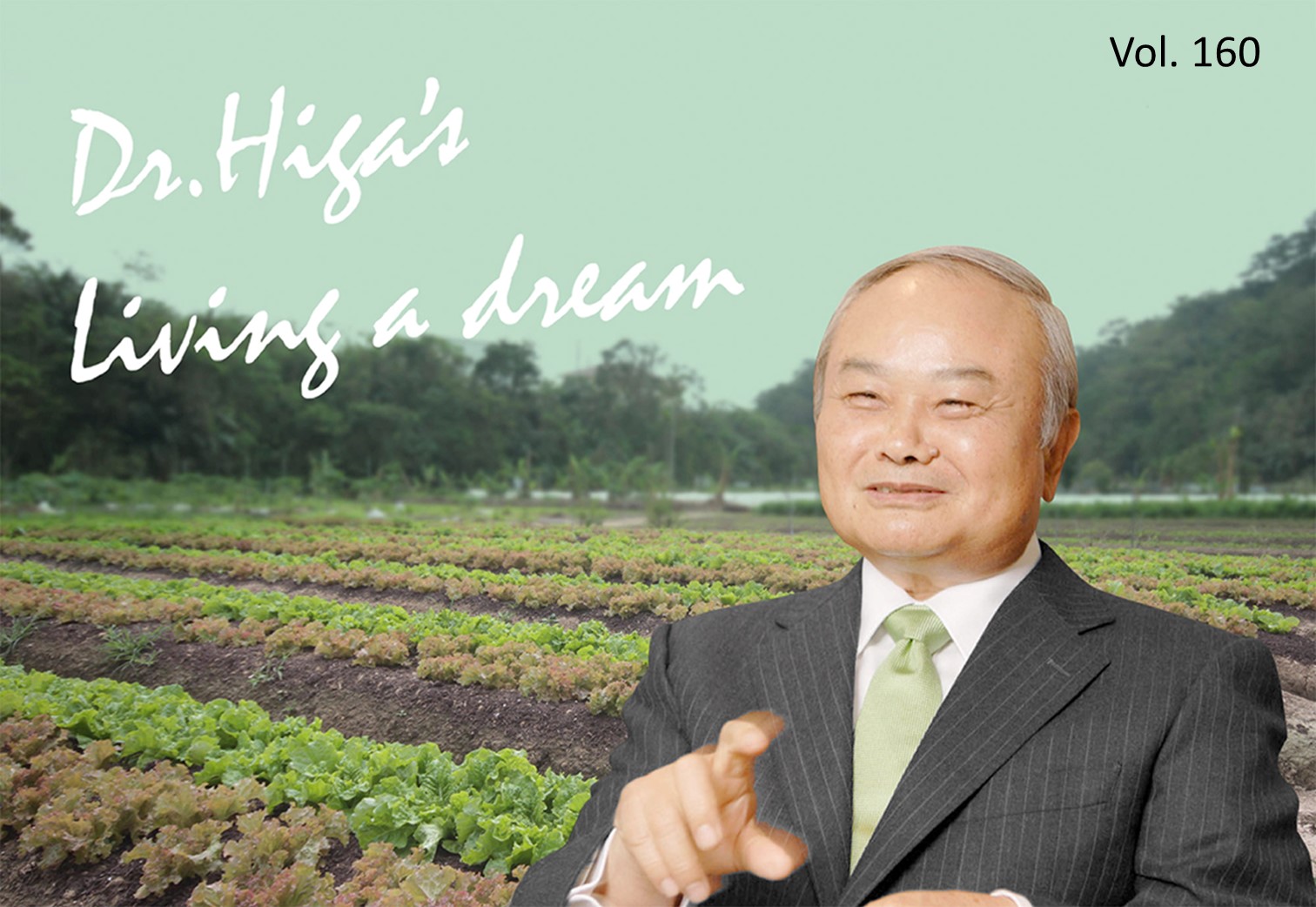
In the previous article, I explained how as we continue to use EM its graviton effect becomes a layered structure, and when it reaches a certain level it self-propagates, reviving the environment and creating a more abundant ecosystem.
Needless to say, proper application of EM technology allows us to convert all discharged organic matter into agricultual and marine resources. As we have already seen, charcoal that has been transferred with EM hado has a high energy rectifying power, enhancing the function of the charcoal and maintaining its effects for a long period of time.
Terra Preta Nova, the miraculous soil found in the Amazon, which maintains its productivity semi-permanently (see DND article series #152, March 2020) and is expected to be a solution to agricultural and environmental problems, uses a rather large amount of charcoal in the soil.
The use of EM charcoal made with smokeless carbonizers, which began seven years ago, has achieved steady results. Takahashi Orchard in Higashine Ciy, Yamagata Prefecture, which started six years ago, has also overcome various difficulties and has now put out brochures touting their full confidence in this technology.
Both of them look younger than they were six years ago. Based on their good results, they are holding a workshop on April 13 to spread the idea to the community. For more details, please refer to the article below from the Yamagata Shinbun newspaper on April 14th.
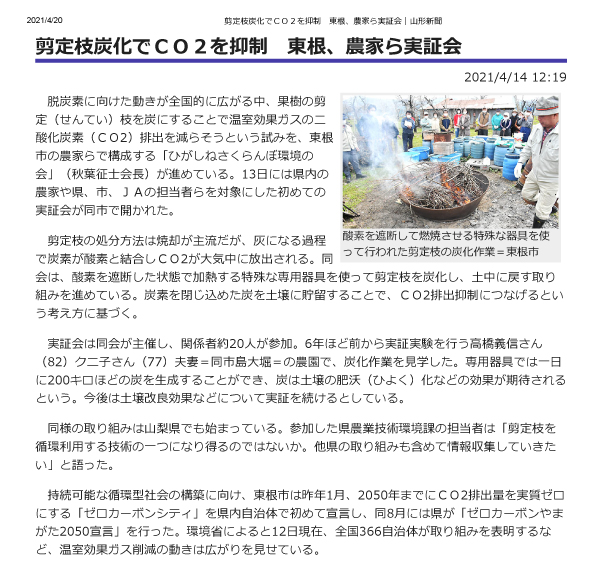
----------------------------------------
Reducing CO2 Emissions by Carbonizing Pruned Branches: A Workshop by Farmers in Higashine Demonstrates How it is Done
April 14, 2021
Photo caption:
Carbonization of pruned branches in Higashine City using a special device that shuts off oxygen and burns them
As the movement toward lowering carbon levels spreads nationwide, the Higashine Cherry Environmental Association (Chairman: Seiji Akiba), consisting of farmers in Higashine City, is taking steps to reduce the emission of carbon dioxide (CO2) from greenhouse gases by turning the pruned branches from fruit trees into charcoal. On the 13th, the first demonstration was held in Higashine City for farmers in Yamagata Prefecture and officials from the prefecture, nearby cities, and JA (Japan Agricultural Cooperatives).
The normal method of disposing of pruned branches is to incinerate them, but in the process of turning them into ash, carbon is combined with oxygen and CO2 is released into the atmosphere.
The Higashine Cherry Environmental Association is working to carbonize the pruned branches using special equipment that heats them while blocking oxygen, and then return them to the soil. The idea is that by storing carbon-encapsulated charcoal in the soil will lead to a reduction of CO2 emissions.
The demonstration was organized by the Association, and about twenty people participated. They observed the carbonization process at the orchard owned by Mr. Yoshinobu Takahashi (82) and Mrs. Kuniko Takahashi (77), who have been conducting demonstration experiments for about six years. The special equipment is capable of producing about 200 kg of charcoal a day, and the charcoal is expected to be effective in improving the fertility of the soil. They plan to continue to demonstrate the effects in improving the soil.
A similar initiative has been launched in Yamanashi Prefecture. An official of the Agricultural Technology and Environment Division of the prefecture who participated in this project commented that, “I think this could be one of the technologies used to recycle pruned branches. I would like to collect further information, including efforts underway in other prefectures.”
With the aim of building a sustainable recycling society, in January last year Higashine City became the first municipality in the prefecture to declare itself a “Zero Carbon City,” with the goal of reducing its CO2 emissions to practically zero by 2050. In August of the same year, the prefecture issued its “Zero Carbon Yamagata 2050 Declaration.” According to the Ministry of the Environment, as of the 12th, 366 local governments nationwide have announced similar efforts, and the movement to reduce greenhouse gas emissions is clearly spreading.
----------------------------------------
This high-hado EM rectifying charcoal should be applied by laying it around the trunk at the base of the tree, or by digging a hole between the trees and putting in about 2 to 3 liters to create an EM barrier (Kekkai.) If this is repeated year after year, the yield and quality of the crop will improve in proportion to the amount of charcoal, and CO2 can be completely recycled.
Needless to say, methods to strengthen the effect of this EM rectifying charcoal will further strengthen the EM Kekkai of the farmland. Mr. Shintani of EM Research Organization provided us with information on this subject, so I will upload it as is.
Needless to say, proper application of EM technology allows us to convert all discharged organic matter into agricultual and marine resources. As we have already seen, charcoal that has been transferred with EM hado has a high energy rectifying power, enhancing the function of the charcoal and maintaining its effects for a long period of time.
Terra Preta Nova, the miraculous soil found in the Amazon, which maintains its productivity semi-permanently (see DND article series #152, March 2020) and is expected to be a solution to agricultural and environmental problems, uses a rather large amount of charcoal in the soil.
The use of EM charcoal made with smokeless carbonizers, which began seven years ago, has achieved steady results. Takahashi Orchard in Higashine Ciy, Yamagata Prefecture, which started six years ago, has also overcome various difficulties and has now put out brochures touting their full confidence in this technology.
<Click image for a larger photo>
Both of them look younger than they were six years ago. Based on their good results, they are holding a workshop on April 13 to spread the idea to the community. For more details, please refer to the article below from the Yamagata Shinbun newspaper on April 14th.

----------------------------------------
Reducing CO2 Emissions by Carbonizing Pruned Branches: A Workshop by Farmers in Higashine Demonstrates How it is Done
April 14, 2021
Photo caption:
Carbonization of pruned branches in Higashine City using a special device that shuts off oxygen and burns them
As the movement toward lowering carbon levels spreads nationwide, the Higashine Cherry Environmental Association (Chairman: Seiji Akiba), consisting of farmers in Higashine City, is taking steps to reduce the emission of carbon dioxide (CO2) from greenhouse gases by turning the pruned branches from fruit trees into charcoal. On the 13th, the first demonstration was held in Higashine City for farmers in Yamagata Prefecture and officials from the prefecture, nearby cities, and JA (Japan Agricultural Cooperatives).
The normal method of disposing of pruned branches is to incinerate them, but in the process of turning them into ash, carbon is combined with oxygen and CO2 is released into the atmosphere.
The Higashine Cherry Environmental Association is working to carbonize the pruned branches using special equipment that heats them while blocking oxygen, and then return them to the soil. The idea is that by storing carbon-encapsulated charcoal in the soil will lead to a reduction of CO2 emissions.
The demonstration was organized by the Association, and about twenty people participated. They observed the carbonization process at the orchard owned by Mr. Yoshinobu Takahashi (82) and Mrs. Kuniko Takahashi (77), who have been conducting demonstration experiments for about six years. The special equipment is capable of producing about 200 kg of charcoal a day, and the charcoal is expected to be effective in improving the fertility of the soil. They plan to continue to demonstrate the effects in improving the soil.
A similar initiative has been launched in Yamanashi Prefecture. An official of the Agricultural Technology and Environment Division of the prefecture who participated in this project commented that, “I think this could be one of the technologies used to recycle pruned branches. I would like to collect further information, including efforts underway in other prefectures.”
With the aim of building a sustainable recycling society, in January last year Higashine City became the first municipality in the prefecture to declare itself a “Zero Carbon City,” with the goal of reducing its CO2 emissions to practically zero by 2050. In August of the same year, the prefecture issued its “Zero Carbon Yamagata 2050 Declaration.” According to the Ministry of the Environment, as of the 12th, 366 local governments nationwide have announced similar efforts, and the movement to reduce greenhouse gas emissions is clearly spreading.
----------------------------------------
This high-hado EM rectifying charcoal should be applied by laying it around the trunk at the base of the tree, or by digging a hole between the trees and putting in about 2 to 3 liters to create an EM barrier (Kekkai.) If this is repeated year after year, the yield and quality of the crop will improve in proportion to the amount of charcoal, and CO2 can be completely recycled.
Needless to say, methods to strengthen the effect of this EM rectifying charcoal will further strengthen the EM Kekkai of the farmland. Mr. Shintani of EM Research Organization provided us with information on this subject, so I will upload it as is.
I received information from Effective Microorganisms Laboratory, Inc. about making a hado source using bamboo instead of plastic bottles, so I would like to share the information with you. Bamboo is hollowed out and filled with EM rectified charcoal, salt, EM, etc. The surface of the bamboo is carbonized by burning it with a burner. When they measured the hado value, they found that it was higher using bamboo than plastic bottles. In fact, there is a positive response from farmers who have used this bamboo-based hado source. Although it is far heavier than plastic bottles, I thought it was a good idea as an option that doesn’t use plastic.
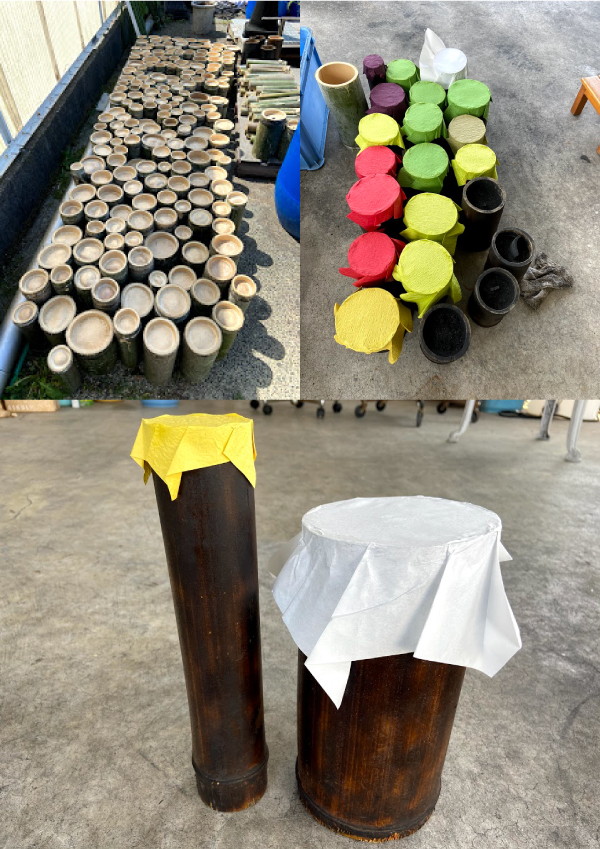
< Information on how to make it will be published on a special rectification page at a later date. >
What’s Happening in Okinawa
The change in the course of Typhoon No. 2 is as reported in the local newspaper as of April 20, but since then, it has been turning to the south and changing its course to the southwest as it approaches Okinawa Island. Since this is the first time such a phenomenon has been observed, it may be an effect of the EM graviton Kekkai in Okinawa, but I would like to wait for further observations. As usual, I will introduce some flowers that appeared in the local newspaper.
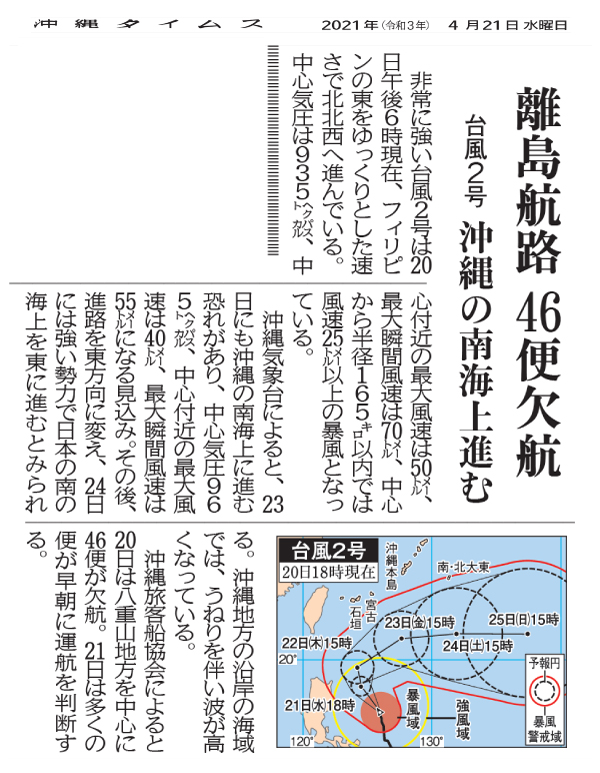
46 ferry boats departures canceled among remote island routes
Typhoon No. 2 moves over the sea south of Okinawa
April 21, 2021 Okinawa Times
As of 6 pm on April 20, Typhoon No.2, an extremely powerful typhoon, is slowly moving north-northwest east of the Philippines. The central pressure is 935 hectopascals, the maximum wind speed near the center is 50 meters, with maximum gusts of 70 meters; within a radius of 165 km from the center, the wind speed is 25 meters or more.
According to the Okinawa Meteorological Observatory, this storm may continue to move over the sea south of Okinawa on the 23rd, with a central pressure of 965 hectopascals, a maximum wind speed of 40 meters near the center, and gusts of 55 meters. After that, it will change its course to the east, and on the 24th, it is expected that it will move eastward, still powerful, over the southern coast of Japan. In the coastal waters of the Okinawa region, the waves are high with swells.
According to the Okinawa Passenger Boat Association, 46 ferry boat departures were cancelled on the 20th, mainly in the Yaeyama region, and the decision whether to resume departures will be made on the early morning of the 21st.
(Courtesy of Okinawa Times)
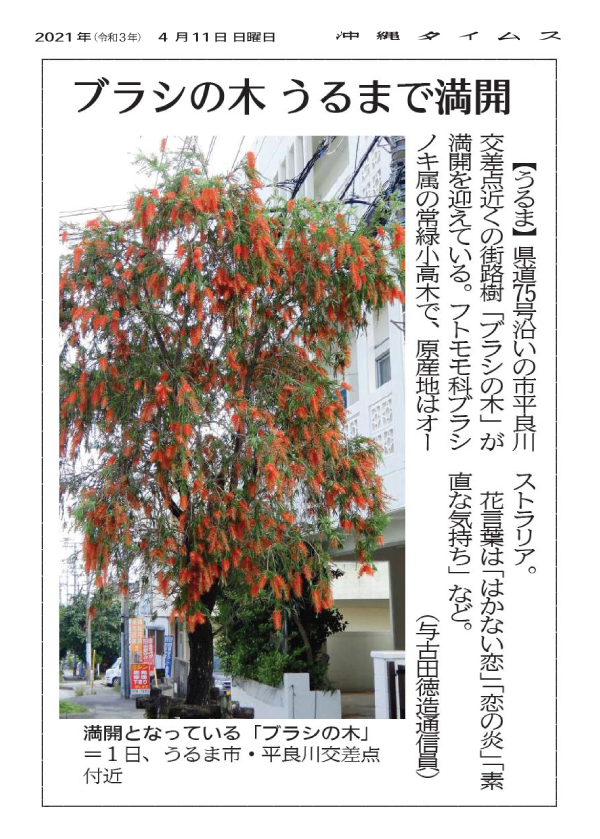
A Bottlebrush tree in full bloom in Uruma City
April 11, 2021, Okinawa Times
The roadside “brush tree” near the Taira River intersection in Uruma City, Okinawa Prefecture, along Prefectural Road 75, is in full bloom. It is an evergreen small tree of the genus Callistemon of the Myrtaceae family, originating in Australia. In hanakotoba (literally, “language of flowers,” meaning the symbolic meaning given to each type of flower) these flowers stand for “fleeting love,” “flame of love,” “honest feelings,” etc. (Tokuzo Yokoda, Reporter)
A bottlebrush tree in full bloom near the Taira River intersection in Uruma City on April 1st.
A bottlebrush tree in full bloom in Uruma City (courtesy of Okinawa Times)
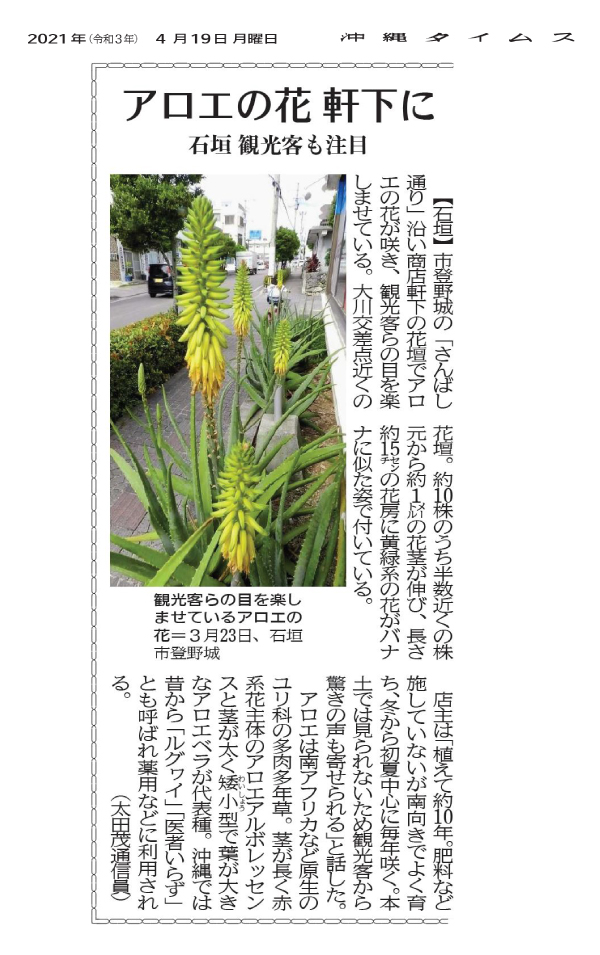
Aloe flowers blossoming under the eaves in Ishigaki City
Attracting Tourists in Ishigaki City
April 19, 2021 Okinawa Times
Aloe flowers blooming in a flowerbed under the eaves of a store along Sanbashi Street in Tonoshiro, Ishigaki City are drawing the attention of tourists. The flowerbed is near the Okawa intersection. About half of the ten plants have flower stalks about one meter long growing from the base of the plants, with yellow-green flowers resembling bananas in clusters about 15 cm in length. The owner of the shop said, “I planted them about ten years ago. Though I haven’t applied any fertilizer, they face south and have grown well and bloom every year, from winter to early summer. Tourists are surprised because these aren’t found on the mainland.”
Aloe is a succulent perennial plant of the Liliaceae family native to South Africa and other parts of the world. Typical species are Aloe arborescens, which has long stems and mainly red flowers, and Aloe vera, which has thick stems, large leaves, and is dwarf size. In Okinawa, Aloe has been called Rugwai, meaning “No need for a doctor,” and is used for medicinal purposes. (Shigeru Ota, Reporter)
Aloe flowers delight the eyes of tourists on March 23, Tonoshiro, Ishigaki City.
Aloe flowers in bloom under the eaves (Courtesy of Okinawa Times)

Begonia in Full Bloom
30,000 Plants Have Turned Red
Izumi, Motobu-cho
April 20, 2021 Okinawa Times
The begonias in Begonia Park in Izumi, Motobu-cho, are now in full bloom. Approximately 30,000 begonias planted on a slope of about 1,500 square meters are now dyed in a crimson color, and can be them enjoyed, along with the greenery of the surrounding hills, as you follow the set route through the park. Ichiro Gushiken, 75, the head of the park, says, “They can be enjoyed and appreciated in different ways, either viewed from below or seen from above.” The best time to view them is before Golden Week holiday, along with the jade vine in a corner of the park.
The park is open from 9am to 6pm.
Admission is 400 yen for adults, 100 yen for high school students and those younger.
For inquiries, call the park at 0980 (47) 2742.
Brightly colored begonias at Begonia Park in Izumi
Begonia in full bloom (Courtesy of Okinawa Times)
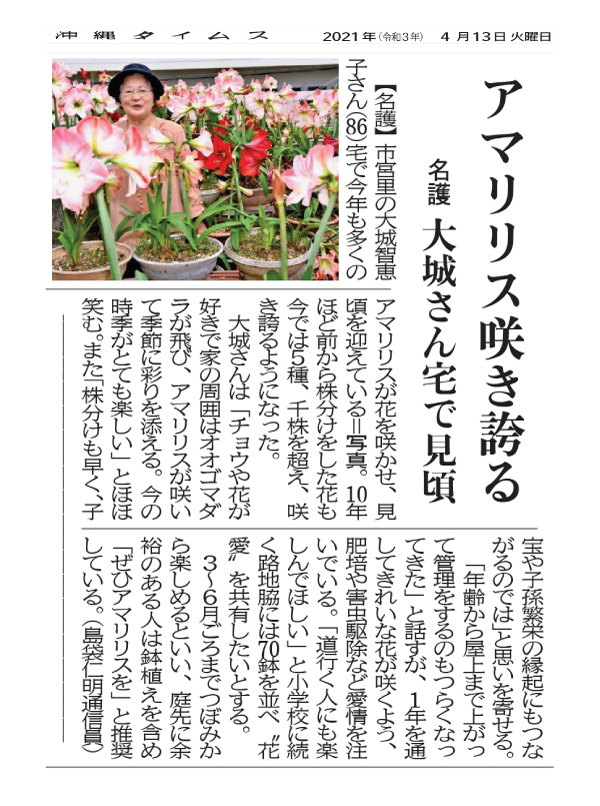
Amaryllis in full bloom
Amaryllis in full bloom at Ms. Oshiro’s house in Nago City
April 13, 2021 Okinawa Times
Many amaryllis are in full bloom at the house of Ms. Chieko Oshiro (86), in Miyazato, Nago City. About ten years ago, she started to divide the roots of the amaryllis, and now there are more than 1,000 plants of five species in full bloom.
Ms. Oshiro said, with a smile, “I like butterflies and flowers, and the area around my house is filled with flying monarch butterflies and blooming amaryllis, adding colors to the season. I really enjoy this time of year.” She also hopes that since the plants she has divided will grow quickly, it will bring good luck for everyone in her family, that they will be blessed with children and that her descendants will prosper. “It is getting harder for me to go up to the rooftop to take care of the flowers because of my age,” she said, but she lovingly cares for them, fertilizing them and ridding them of any pests so that beautiful flowers will bloom throughout the year. She has lined up 70 flowerpots along the alley leading to the elementary school, hoping that passersby will also enjoy them and share her love of flowers. Amaryllis can be enjoyed from March to June when they are still in buds, so if you have room in your garden, she encourages you to grow amaryllis, including growing them in planters.
(Yoshiaki Shimabukuro, Reporter)
Amaryllis in full bloom (courtesy of Okinawa Times)
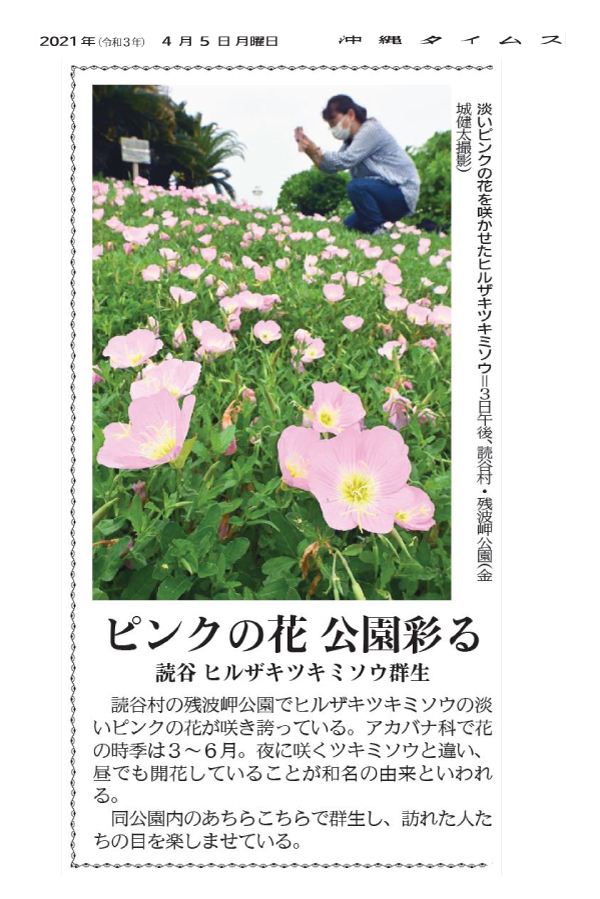
Pink flowers decorate the park
Primrose growing in colonies in Yomitan Village
April 5, 2021 Okinawa Times
The pale pink flowers of Primroses are in full bloom at Cape Zanpa Park in Yomitan Village, Okinawa Prefecture. The flowers are in the red flower family and bloom from March to June. Unlike evening primroses, which bloom at night, it is said that the Japanese name, Hiruzaki Tsukimiso, comes from the fact that these bloom even in the daytime. (Hiruzaki means “blooming during the day.”) They grow in clusters here and there in the park, and delight the eyes of visitors.
Primroses with pale pink flowers, on the afternoon of April 4th at Cape Zanpa Park in Yomitan Village. (Photo by Kenta Kinjo)
Pink flowers adorn the park (Courtesy by Okinawa Times)
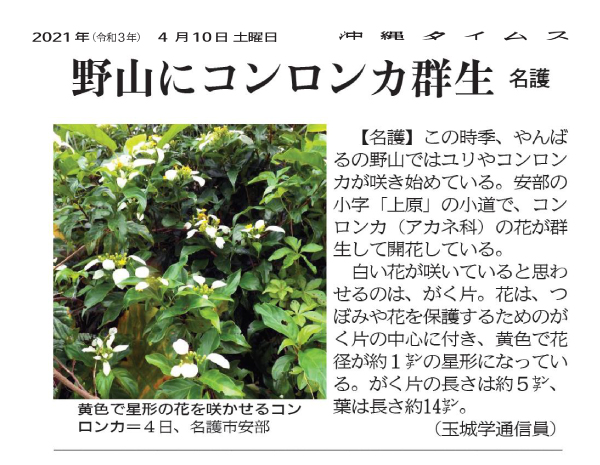
Konronka (Mussaenda parviflora) are growing in colonies in hills and fields
Nago City
April 10, 2021 Okinawa Times
During this season, lilies and konronka are beginning to bloom in the hills and fields of Yanbaru, the forested northern part of Okinawa. On the path at Kanbaru of Abu, Nago City, Konronka flowers (of the Rubiaceae family) are blooming in clusters. It is actually the sepals that give you the sense that white flowers are in bloom. The flowers are attached to the center of the sepals, which protect the buds and flowers and are yellow and star-shaped with a diameter of about 1 cm. The sepals are about 5 cm long and the leaves are about 14 cm long.
(Manabu Tamaki, Reporter)
Konronka with yellow star-shaped flowers
April 4th, in Abu, Nago City
Konronka in bloom in the hills and fields (Courtesy of Okinawa Times)
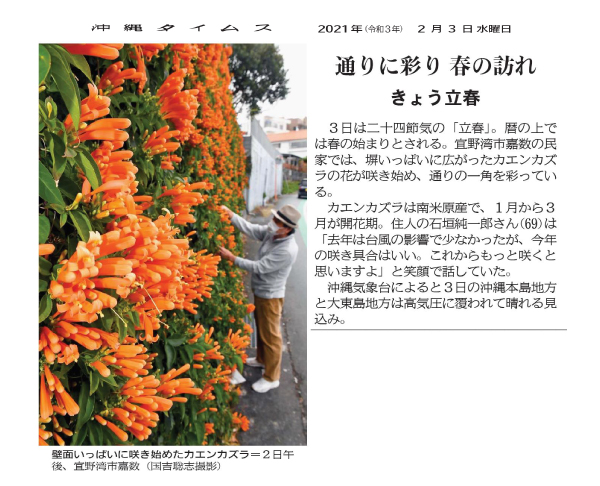 Adorning the streets The arrival of spring
Adorning the streets The arrival of spring
The first day of spring
February 3, 2021 Okinawa Times
February 3rd is called Risshun in the 24 Solar Terms (the traditional division of four seasons into six parts each), which is the beginning of spring on the calendar. At a private house in Kakazu, Ginowan City, flame vine flowers covering the walls have begun to bloom, beautifully decorating a corner of the street.
Flame vine is native to South America, and its flowering season is from January to March. Junichiro Ishigaki, 69, a local resident, happily noted that, “Last year, only a few flowers bloomed due to the typhoons, but his year’s blooms are beautiful. I’m sure there will be even more blooming.”
According to the Okinawa Meteorological Observatory, the 3rd should see a high pressure system and sunny skies in the Okinawa and Daito Island regions.
Flame vines, which have begun to blossom all over a wall in Kakazu, Ginowan City, on the afternoon of February 2nd. (Photo by Satoshi Kuniyoshi)
Adorning the streets The arrival of spring (Courtesy of Okinawa Times)
(May 13, 2021)

46 ferry boats departures canceled among remote island routes
Typhoon No. 2 moves over the sea south of Okinawa
April 21, 2021 Okinawa Times
As of 6 pm on April 20, Typhoon No.2, an extremely powerful typhoon, is slowly moving north-northwest east of the Philippines. The central pressure is 935 hectopascals, the maximum wind speed near the center is 50 meters, with maximum gusts of 70 meters; within a radius of 165 km from the center, the wind speed is 25 meters or more.
According to the Okinawa Meteorological Observatory, this storm may continue to move over the sea south of Okinawa on the 23rd, with a central pressure of 965 hectopascals, a maximum wind speed of 40 meters near the center, and gusts of 55 meters. After that, it will change its course to the east, and on the 24th, it is expected that it will move eastward, still powerful, over the southern coast of Japan. In the coastal waters of the Okinawa region, the waves are high with swells.
According to the Okinawa Passenger Boat Association, 46 ferry boat departures were cancelled on the 20th, mainly in the Yaeyama region, and the decision whether to resume departures will be made on the early morning of the 21st.
(Courtesy of Okinawa Times)

A Bottlebrush tree in full bloom in Uruma City
April 11, 2021, Okinawa Times
The roadside “brush tree” near the Taira River intersection in Uruma City, Okinawa Prefecture, along Prefectural Road 75, is in full bloom. It is an evergreen small tree of the genus Callistemon of the Myrtaceae family, originating in Australia. In hanakotoba (literally, “language of flowers,” meaning the symbolic meaning given to each type of flower) these flowers stand for “fleeting love,” “flame of love,” “honest feelings,” etc. (Tokuzo Yokoda, Reporter)
A bottlebrush tree in full bloom near the Taira River intersection in Uruma City on April 1st.
A bottlebrush tree in full bloom in Uruma City (courtesy of Okinawa Times)

Aloe flowers blossoming under the eaves in Ishigaki City
Attracting Tourists in Ishigaki City
April 19, 2021 Okinawa Times
Aloe flowers blooming in a flowerbed under the eaves of a store along Sanbashi Street in Tonoshiro, Ishigaki City are drawing the attention of tourists. The flowerbed is near the Okawa intersection. About half of the ten plants have flower stalks about one meter long growing from the base of the plants, with yellow-green flowers resembling bananas in clusters about 15 cm in length. The owner of the shop said, “I planted them about ten years ago. Though I haven’t applied any fertilizer, they face south and have grown well and bloom every year, from winter to early summer. Tourists are surprised because these aren’t found on the mainland.”
Aloe is a succulent perennial plant of the Liliaceae family native to South Africa and other parts of the world. Typical species are Aloe arborescens, which has long stems and mainly red flowers, and Aloe vera, which has thick stems, large leaves, and is dwarf size. In Okinawa, Aloe has been called Rugwai, meaning “No need for a doctor,” and is used for medicinal purposes. (Shigeru Ota, Reporter)
Aloe flowers delight the eyes of tourists on March 23, Tonoshiro, Ishigaki City.
Aloe flowers in bloom under the eaves (Courtesy of Okinawa Times)

Begonia in Full Bloom
30,000 Plants Have Turned Red
Izumi, Motobu-cho
April 20, 2021 Okinawa Times
The begonias in Begonia Park in Izumi, Motobu-cho, are now in full bloom. Approximately 30,000 begonias planted on a slope of about 1,500 square meters are now dyed in a crimson color, and can be them enjoyed, along with the greenery of the surrounding hills, as you follow the set route through the park. Ichiro Gushiken, 75, the head of the park, says, “They can be enjoyed and appreciated in different ways, either viewed from below or seen from above.” The best time to view them is before Golden Week holiday, along with the jade vine in a corner of the park.
The park is open from 9am to 6pm.
Admission is 400 yen for adults, 100 yen for high school students and those younger.
For inquiries, call the park at 0980 (47) 2742.
Brightly colored begonias at Begonia Park in Izumi
Begonia in full bloom (Courtesy of Okinawa Times)

Amaryllis in full bloom
Amaryllis in full bloom at Ms. Oshiro’s house in Nago City
April 13, 2021 Okinawa Times
Many amaryllis are in full bloom at the house of Ms. Chieko Oshiro (86), in Miyazato, Nago City. About ten years ago, she started to divide the roots of the amaryllis, and now there are more than 1,000 plants of five species in full bloom.
Ms. Oshiro said, with a smile, “I like butterflies and flowers, and the area around my house is filled with flying monarch butterflies and blooming amaryllis, adding colors to the season. I really enjoy this time of year.” She also hopes that since the plants she has divided will grow quickly, it will bring good luck for everyone in her family, that they will be blessed with children and that her descendants will prosper. “It is getting harder for me to go up to the rooftop to take care of the flowers because of my age,” she said, but she lovingly cares for them, fertilizing them and ridding them of any pests so that beautiful flowers will bloom throughout the year. She has lined up 70 flowerpots along the alley leading to the elementary school, hoping that passersby will also enjoy them and share her love of flowers. Amaryllis can be enjoyed from March to June when they are still in buds, so if you have room in your garden, she encourages you to grow amaryllis, including growing them in planters.
(Yoshiaki Shimabukuro, Reporter)
Amaryllis in full bloom (courtesy of Okinawa Times)

Pink flowers decorate the park
Primrose growing in colonies in Yomitan Village
April 5, 2021 Okinawa Times
The pale pink flowers of Primroses are in full bloom at Cape Zanpa Park in Yomitan Village, Okinawa Prefecture. The flowers are in the red flower family and bloom from March to June. Unlike evening primroses, which bloom at night, it is said that the Japanese name, Hiruzaki Tsukimiso, comes from the fact that these bloom even in the daytime. (Hiruzaki means “blooming during the day.”) They grow in clusters here and there in the park, and delight the eyes of visitors.
Primroses with pale pink flowers, on the afternoon of April 4th at Cape Zanpa Park in Yomitan Village. (Photo by Kenta Kinjo)
Pink flowers adorn the park (Courtesy by Okinawa Times)

Konronka (Mussaenda parviflora) are growing in colonies in hills and fields
Nago City
April 10, 2021 Okinawa Times
During this season, lilies and konronka are beginning to bloom in the hills and fields of Yanbaru, the forested northern part of Okinawa. On the path at Kanbaru of Abu, Nago City, Konronka flowers (of the Rubiaceae family) are blooming in clusters. It is actually the sepals that give you the sense that white flowers are in bloom. The flowers are attached to the center of the sepals, which protect the buds and flowers and are yellow and star-shaped with a diameter of about 1 cm. The sepals are about 5 cm long and the leaves are about 14 cm long.
(Manabu Tamaki, Reporter)
Konronka with yellow star-shaped flowers
April 4th, in Abu, Nago City
Konronka in bloom in the hills and fields (Courtesy of Okinawa Times)
 Adorning the streets The arrival of spring
Adorning the streets The arrival of springThe first day of spring
February 3, 2021 Okinawa Times
February 3rd is called Risshun in the 24 Solar Terms (the traditional division of four seasons into six parts each), which is the beginning of spring on the calendar. At a private house in Kakazu, Ginowan City, flame vine flowers covering the walls have begun to bloom, beautifully decorating a corner of the street.
Flame vine is native to South America, and its flowering season is from January to March. Junichiro Ishigaki, 69, a local resident, happily noted that, “Last year, only a few flowers bloomed due to the typhoons, but his year’s blooms are beautiful. I’m sure there will be even more blooming.”
According to the Okinawa Meteorological Observatory, the 3rd should see a high pressure system and sunny skies in the Okinawa and Daito Island regions.
Flame vines, which have begun to blossom all over a wall in Kakazu, Ginowan City, on the afternoon of February 2nd. (Photo by Satoshi Kuniyoshi)
Adorning the streets The arrival of spring (Courtesy of Okinawa Times)
(May 13, 2021)
Editor’s Picks
-

#196 The Steadily Evolving EM Nature Farming Method at the Blue Sky Palace - Part 6 -
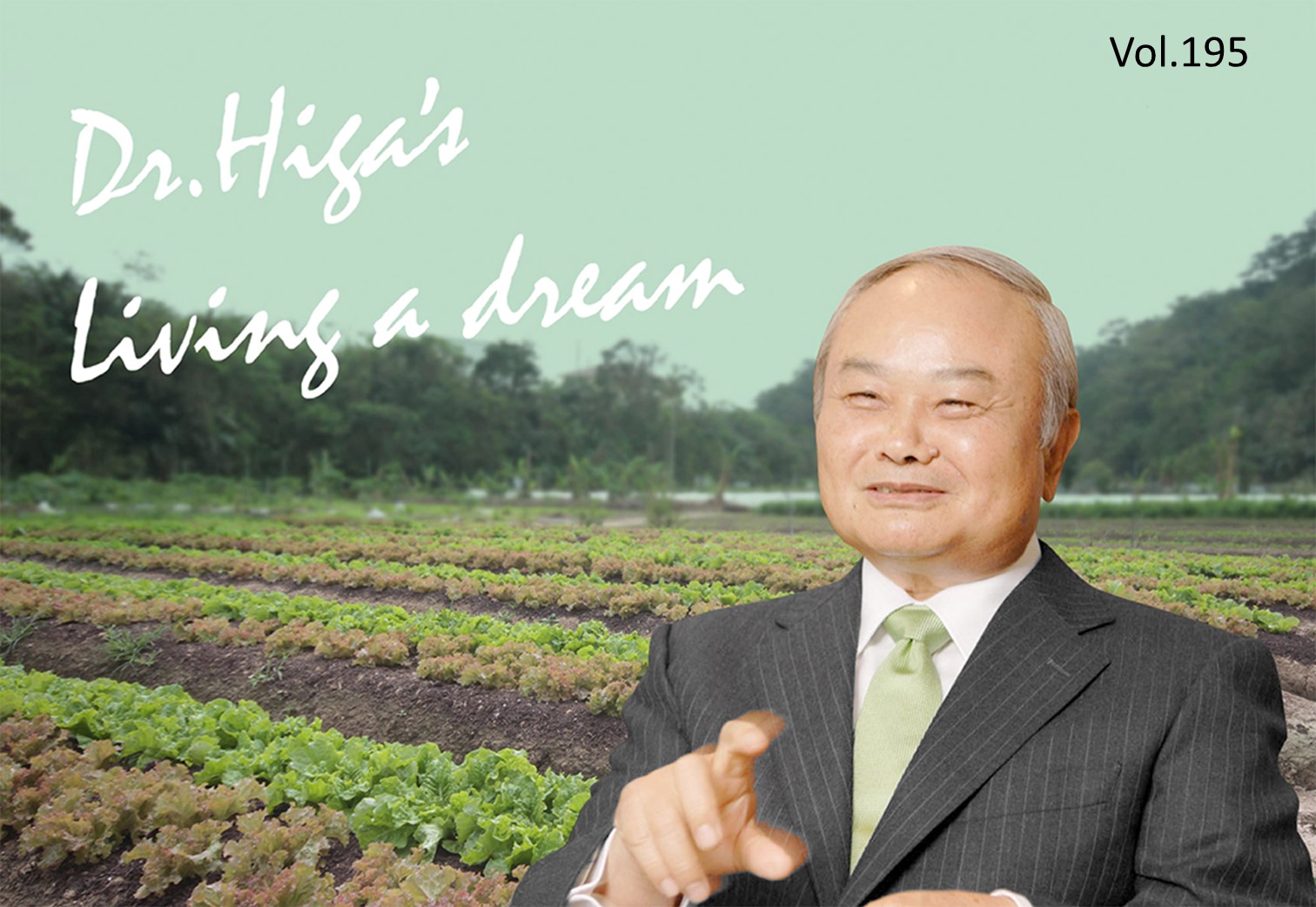
#195 The Steadily Evolving EM Nature Farming Method at the Blue Sky Palace - Part 5 -

#191 Steadily Evolving EM Nature Farming Method at the Blue Sky Palace -
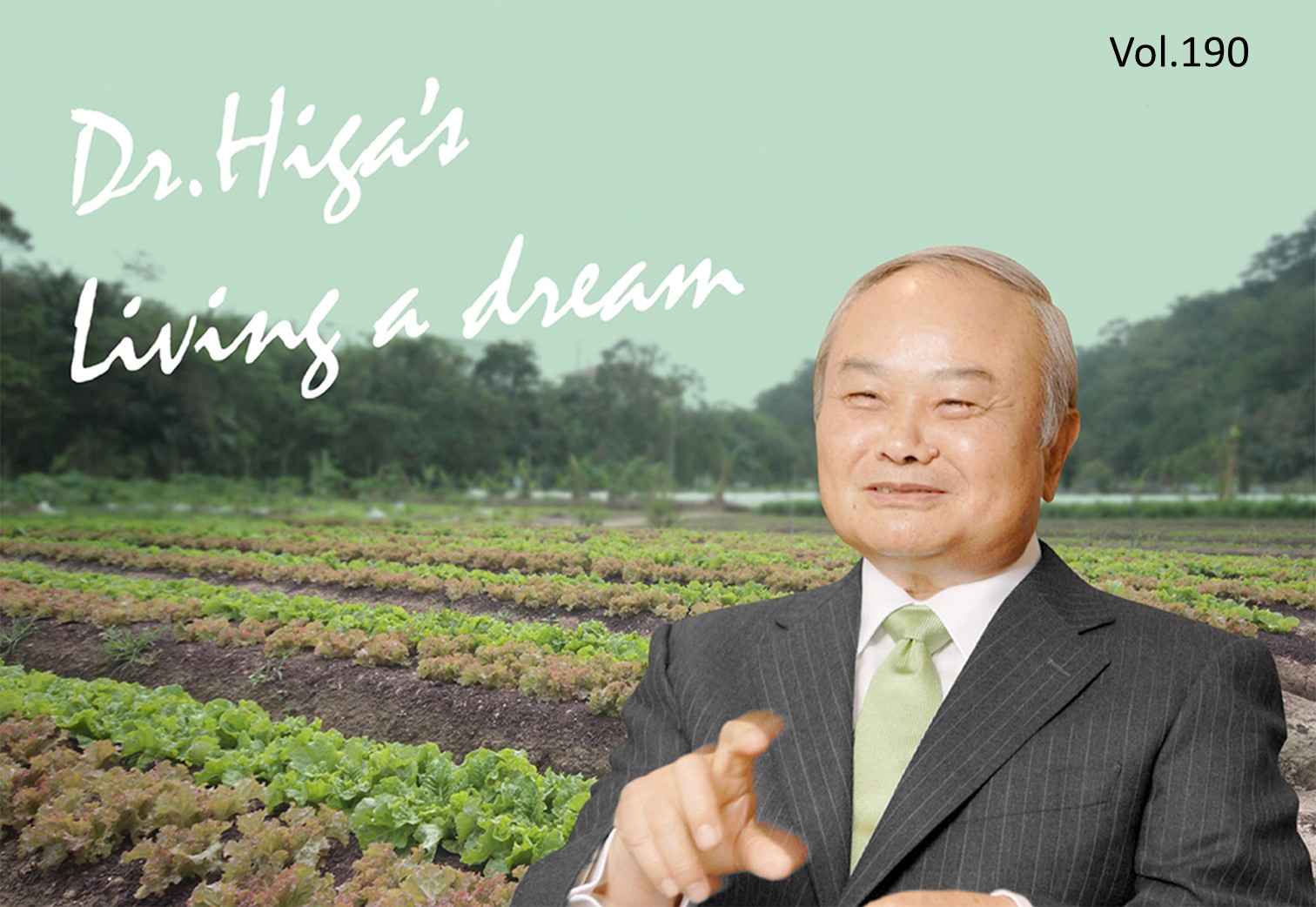
#190 Quantum Mechanical Effects of EM Gravitron Charcoal
- 2025
- Sep:#209 The Widespread Use of EM in Ecuador
- Sep:#208 The Widespread Use of EM in Chile
- Jul:#207 Peru, where EM has taken root throughout the country
- May:#206 EM Application Technology in Paraguay Begins to Evolve into Advanced Circular Agriculture
- May:#205 Practical Application of Soil Disinfectant-Free Cultivation Using EM Technology
- Apr:#204 How EM Use Has Spread Throughout the Philippines
- Mar:#203 How to Use EM to Fundamentally Solve the Problem of Agricultural Residue Burning
- Feb:#202 The Spread of EM technology in Germany
- Jan:#201 The 2nd Ichiro Masaki Memorial Universal Village EM International Conference
- Jan:#200 Cleanup of the Ala Wai Canal in Hawaii, where social bonds are strengthened using EM
- 2024
- Nov:#199 EM trials in India with bananas, tomatoes, and pomegranates
- Oct:#198 The Steadily Evolving EM Nature Farming Method at the Blue Sky Palace - Part 8
- Sep:#197 The Steadily Evolving EM Nature Farming Method at the Blue Sky Palace - Part 7
- Aug:#196 The Steadily Evolving EM Nature Farming Method at the Blue Sky Palace - Part 6
- Jul:#195 The Steadily Evolving EM Nature Farming Method at the Blue Sky Palace - Part 5
- Jun:#194 Steadily Evolving EM Nature Farming Method at the Blue Sky Palace - Part 4
- May:#193 Steadily Evolving EM Nature Farming Method at the Blue Sky Palace - Part 3
- May:#192 Steadily Evolving EM Nature Farming Method at the Blue Sky Palace - Part 2
- Apr:#191 Steadily Evolving EM Nature Farming Method at the Blue Sky Palace
- Mar:#190 Quantum Mechanical Effects of EM Gravitron Charcoal
- Mar:#189 The barrier space in Okinawa (Ryukyu Islands) has risen to another dimension
- Jan:#188 Sixty Days after Typhoon No.6
- 2023
- Oct:#187 Supermassive Typhoon No.6 and Subsequent Typhoon No. 11
- Sep:#186 Massive Typhoon No.6 that swallowed the Ryukyu Islands Graviton barrier
- Sep:#185 August 8th is World “EM Mudball Day”
- Aug:#184 A disease-free life depends on the health of the intestinal microbiome.
- Jul:#183 Trial and Error at the Blue-Sky Palace, Part 3
- Jun:#182 Trial and Error at the Blue-Sky Palace, Part 2
- Apr:#181 Trial and Error at the Blue-Sky Palace
- Mar:#180 Ala Wai Canal Cleanup Project in Waikiki, Hawaii
- Feb:#179 High-Yield, High-Quality Rice Production Using EM
- Feb:#178 The Progress the "Soil Preparation Workshop" of the Oishi 3-chan Club (Part 2)
- Jan:#177 Organic Farming Instructional Manual Using EM
- 2022
- Nov:#176 The Typhoon Situation in Okinawa in 2022
- Sep:#175 Third-Party Verification of the Graviton barrier in Okinawa Part-2
- Sep:#174 Third-Party Verification of the Graviton barrier in Okinawa
- Aug:#173 Ecosystem Changes Observed in Okinawa in 2021 Part-5
- Jun:#172 Ecosystem Changes Observed in Okinawa in 2021 Part-4
- May:#171 Ecosystem Changes Observed in Okinawa in 2021 Part-3
- Apr:#170 Ecosystem Changes Observed in Okinawa in 2021 Part-2
- Mar:#169 Koizumi Farm in Kamakura Continues to Evolve
- Feb:#168 Ecosystem Changes Observed in Okinawa in 2021 Part-1
- 2021
- Dec:#167 Enjoying EM Technology While Enriching the Local Ecosystem
- Nov:#166 A Case Study of the Use of EM in a Next Generation Free School in Tune with the Cycles of Nature
- Oct:#165 Typhoon conditions and flowers in Okinawa from August to October
- Sep:#164 Re-learning the origins of river purification using EM Cleaning up the Dairyuji River in Senami (Murakami City, Niigata Prefecture)
- Aug:#163 Measures Against Natural Disasters and Re-learning the Starting Point of EM
- Jul:#162 Summary of FFC (Foods for Children) Okinawa Forum 2021
- Jun:#161 Restoring the Vigor of an Old Tree and Purifying the Environment with EM Technology That Even an Amateur Can Do
- May:#160 The Public is Beginning to Recognize the Use of EM Smokeless Carbonizers
- Apr:#159 EM Hado (EM Graviton) that exerts quantum superposition effect over time
- Mar:#158 Virus-free Okinawan Plants Through Use of an EM Graviton Barrier
- Jan:#157 Enjoyable Farming for Self-Sufficiency that Even Amateurs Can Do
- 2020
- Dec:#156 EM quantum energy effect occurring in Okinawa
- Nov:#155 Implementing EM graviton farming as a flood countermeasure for apple orchards
- Oct:#154 The Latest Book on the Practical Uses of EM "You Are the One Who Draws Out the Power of Microorganisms," by Chizuko Nomoto
- Sep:#153 Application of EM technology to long periods of rain, lack of sunshine, storms, heavy rains, etc.
- Aug:#152 EM application in Kitanakagusuku village plant waste recycling yard
- Jul:#151 Natural Disaster Countermeasures Using EM Technology: Part 2
- Jul:#150 Natural Disaster Countermeasures Using EM Technology
- May:#149 How to make your home and workplace an energy spot by living a complete EM lifestyle: creating the ultimate source of health and environmental purification
- Apr:#148 EM, Viruses and the Pandemic
- Apr:#147 New agriculture applying quantum mechanics Part 2
- Apr:#146 New agriculture applying quantum mechanics
- Apr:#145 Wonderful EM Miracle
- 2019
- Nov:#144 The movie “Revival II” and the reality of Fukushima
- Oct:#143 Boundary dome and foliar spraying of EM・X GOLD and EM 3
- Oct:#142 Kirakira (Sparkling) Summer Vegetable Festa in 2019
- Aug:#141 Excessive salt inevitably causes salt damage
- Jul:#140 Diverse applications of charcoal Part 3
- Jun:#139 Diverse applications of charcoal Part 2
- Jun:#138 Diverse applications of charcoal
- Jun:#137 Purification power of salt
- May:#136 The degree of soil contamination is a reflection of the microflora
- May:#135 Definitive use of EM barriers to deal with typhoons
- May:#134 Implementing authentic Nature Farming
- May:#133 How to enhance healthy Hado (wave energy) by EM
- May:#132 Eating Dirt (Soil)
- May:#131 Hado (Wave energy) involved in health
- May:#130 Reaffirming EM technology to realize the essence of agriculture
- May:#129 The 2nd EM Producer Networking Meeting
- Apr:#128 Understanding the application of seawater and salt in crop cultivation
- Apr:#127 Prevention of Disasters by EM Technology
- Mar:#126 Quantum overlay effective utilization of EM
- Jan:#125 EM Disaster Recovery Support Projects in 2017
- 2018
- 2017
- Aug:#121 Escape from conventional agricultural traps
- Jul:#120 Limitation and important caveats regarding utilization of salt
- Jun:#119 EM Technology to Break Through the Limits of Pesticide-Free Strawberries
- May:#118 Application of barriers using EM rectification force
- Apr:#117 The 1st EM Produce Growers' Networking Conference
- Mar:#116 Sumizo kun: The Ultimate Versatile Carbonization Equipment
- Feb:#115 How to make and use simple carbonized and rectified ash
- Jan:#114 Achievements of 2016
- 2016
- Dec:#113 Definitive Measures Against Typhoons
- Nov:#112 International Conference on Universal Village
- Oct:#111 90% of Your Body is Microbes
- Sep:#110 Disaster Countermeasures Using EM
- Aug:#109: Changes in the Natural Environment by EM Barrier Domes in Okinawa
- Jul:#108: Multi-purpose Utilization of Activated EM with Seawater and Salt
- Jun:#107: Marine Day, when EM Mudballs and Activated EM are Applied Throughout Japan
- May:#106: The Function of EM and Gravitational Waves–Part 3
- Apr:#105: The Function of EM and Gravitational Waves–Part 2
- Feb:#104: The Function of EM and Gravitational Waves
- Feb:#103: The Importance of Phototrophic Bacteria in EM
- 2015
- Dec:#102: Results of Environmental Forum "Utsukushima EM Paradise" 2015
- Nov:#101: Environmental Forum "Utsukushima EM Paradise" 2015
- Oct:#100: A New Phase of Limit Breakthrough Using EM
- Sep:#99: A New Phase of Limit Breakthrough through EM
- Aug:#98: The Tokyo Bay Area Began Creating a Truly Livable Hometown
- Jul:#97: Rectifying Effects of EM
- Jun:#96: Lake Suwa Sousei lecture
- May:#95: In Order to Further Ensure Limit Breakthrough
- Apr:#94: Theatrical Release of the Documentary Film SOSEI-Revival to Enlighten People on the New Possibilities of Microorganisms
- Mar:#93: What Underlies Limit Breakthrough (Part 2)
- Feb:#92: EM Functions to Break Through Limits
- Jan:#91: At the Start of 2015
- 2014
- Dec:#90: Looking Back at 2014
- Nov:#89: Shikoku EM FESTA 2014, Virtuous Circle Conference in Matsuyama, Ehime Prefecture
- Oct:#88: Using EM to Deal with Weather Disasters (Part 2)
- Sep:#87: Current Status of Radioactivity Measures Using EM in Fukushima
- Aug:#86: APNAN (Asia Pacific Natural Agriculture Network) 25th Anniversary Conference in 2014
- Jul:#85: Using EM to Deal with Weather Disasters
- Jun:#84: Substantial Improvement of Soil
- May:#83: The Energy Rectification Force of EM
- Apr:#82: The Annual 18th EM Technology Exchange Meeting and Tohoku Conference in Shichigahama
- Mar:#81: Salmon going upstream in Kitaura (Kasumigaura)
- Feb:#80: The Microbiome Again
- Jan:#79: Inauguration of the Federation of Diet Members Who Use and Apply Effective Microorganisms
- 2013
- Dec:#78: Receiving an Honorary Doctoral Degree from Rajamangala University of Technology in Thailand
- Nov:#77: The Use of EM in School Education in Bhutan
- Oct:#76: Well of Bonding
- Sep:#75: The Background to EM Not Being Employed by Public Institutions to Deal with Radiation
- Aug:#74: Dealing with Disaster: Using EM in Crisis Management
- Jul:#73: EM Events on Ocean Day
- Jun:#72: Using EM to Deal With Heat Stroke and Summer Heat Fatigue
- May:#71: An EM Model Town in Malaysia
- Apr:#70: Steps the Japanese Government is Taking to Deal with Radiation: Are They Really Safe?
- Mar:#69: EM Group Disaster Reconstruction Aid Project in Fukushima
- Feb:#68: EM and Microbiomes (Microbial Flora)
- Jan:#67: A Necessary Evil is Still Evil
- 2012
- Dec:#66: The 17th National EM Technology Exchange Conference / Hokkaido Conference in Sapporo
- Nov:#65: EM Forum 2012 in Okinawa and the Environmental Forum in Fukushima
- Oct:#64: 2012 EM Forum
- Sep:#63: A New Earth Saving Revolution
- Aug:#62: The Asahi Newspaper’s Misguided Reports About EM
- Jul:#61: Using EM in Radioactive Contamination Measures in Fukushima Prefecture
- Jun:#60: The Effects of Using EM to Inhibit the Absorption of Radioactivity as Confirmed in Fukushima
- May:#59: Recovery Support for the Great East Japan Earthquake
- Apr:#58: The Royal Kingdom of Thailand, in which EM Functions as a Set Government Policy
- Mar:#57: Report on the Measures Taken by Kingdom of Thailand Using EM to Deal with Polluted Water
- Feb:#56 EM™ as Part of National Policy in Thailand to Deal with Sanitation Issues Resulting from the Flood of 2011
- Jan:#55 The Law of Syntropy (Revitalization)
- 2011
- Dec:#54 EM Forum 2011
- Nov:#53 Shikoku EM Festa 2011- Zenjunkan no Wa (Virtuous Circle) Tokushima Conference in Naruto -
- Oct:#52 The Mystery of Interim Safety Values for Radioactive Material
- Sep:#51 Successful Radiation Countermeasures Using EM
- Aug:#50 Events on Sea Day in which EM Mud Balls are Thrown into the Water and Activated EM is Applied.
- May:#47 Dealing with the Damage Caused by the Eastern Japan Earthquake
- Apr:#46 Eastern Japan Earthquake
- Mar:#45 The 16th National EM Technology Hokuriku Conference in Fukui
- Feb:#44 More Thoughts on Avian Influenza and Foot-and-Mouth Disease
- Jan:#43 Happy New Year!
- 2010
- Dec:#42 Shikoku EM FESTA 2010・Zenjunkan no wa (Virtuous Circle) Fellowship Conference in Tobe, Ehime Prefecture
- Nov:#41 EM Forum 2010
- Oct:#40: My Thanks to the EM™ Volunteers Who Helped in the Fight Against Foot-and-Mouth Disease in Miyazaki Prefecture
- Sep:#39 International EM Mud Ball Day
- Jul:#37 Poland EM Forum 2010
- Jun:#36 EM Countermeasures Against Foot-and-Mouth Disease
- May:#35 Abnormal Weather
- Apr:#34 EM Activities in Thailand: Finding Solutions to the Challenges Facing the Nation
- Mar:#33 New Developments in the Evolution of EMTM in Thailand
- Feb:#32 Results Starting to Be Seen at the Mikasa Project
- Jan:#31 Towards an EM-Use Society
- 2009
- Dec:#30 EM Summit
- Nov:#29 The System in Penang State in Malaysia that Made the World EMTM Mudball Day a Success
- Oct:#28 The "World EM Mudball Day" in Malaysia
- Sep:#27 Validating EMTM Medicine: Case Study Reports from EM Users 2009. (Part 3)
- Sep:#26 Validating EMTM Medicine: Case Study Reports from EMTM Users 2009. (Part 2)
- Jul:#25 Validating EMTM Medicine: Case Study Reports from EMTM Users 2009. (Part 1)
- Jun:#24 Activities to Disseminate EM-Focused Nature Farming in China
- May:#23 Use of EMTM in Response to Swine Flu
- Apr:#22 Using EM to Solve Public Administrative Costs
- Mar:#21 Reaffirming the Versatility of EM
- Jan:#20 The Beginning of a New Era
- 2008
